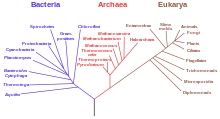Poslední univerzální společný předek


Poslední univerzální společný předek (LUCA – last universal common ancestor) je hypotetický poslední společný předek všech organismů, z něhož se vyvinul veškerý dnešní život na Zemi. Odhaduje se, že LUCA žil před 3,5 až 4,1 miliardami let[1] či 4,32 až 4,52 miliardami let.[2]
Existují rozdílné názory na konkrétní charakter organismů LUCA, jejich životní prostředí a způsob výživy. Velmi pravděpodobně se jednalo o jednoduché mikroskopické jednobuněčné prokaryotní organismy, podobné dnešním bakteriím či archebakteriím, které využívaly nepohlavní rozmnožování a žily ve vodě. Všeobecně se přijímá, že se živily heterotrofně, zejména novější studie však podporují možnost autotrofní výživy.
Horizontální přenos genetické informace ale ukazuje, že organismy pocházejí spíše ze skupiny předků.
Znaky tohoto předka
Na základě vlastností sdílených všemi nezávisle žijícími organismy[3][4] se odhadují vlastnosti, která musela mít LUCA před tím, než začaly vznikat jednotlivé evoluční větve.
K těmto vlastnostem patří:
- Genetický kód
- Genetický kód založený na DNA,
- DNA složené z deoxyadenosinu, deoxycytidinu, deoxythymidinu a deoxyguanosinu a možná z dalších deoxynukleotidů
- genetický kód je tvořen třínukleotidovými kodony, čímž vzniká 64 možností, jak řadit nukleotidy; protože je však jen 20 aminokyselin, jednu aminokyselinu kóduje více kodonů. Tyto vybrané kodony sdílí eukaryota i prokaryota, ale například archea a mitochondrie mají určité odchylky,
- DNA je dvouvláknová, tuto vlastnosti udržuje DNA polymeráza
- integrita DNA je udržována skupinou enzymů, včetně topoisomerázy, ligázy a dalších opravných enzymů,
- kód je exprimován díky RNA, které jsou jednovláknové,
- tato RNA vzniká díky činnosti RNA polymerázy, při vzniku RNA se thymidin nahrazuje za uridin,
- exprimací kódu vznikají proteiny, všechny další vlastnosti organismu (př. syntéza lipidů) jsou závislé na bílkovinných enzymech vznikajících právě cestou exprimace
- Metabolismus
- ribozómy se skládají ze dvou podjednotek, jedné malé a jedné velké
- každá ribozomální podjednotka obsahuje jádro z rRNA a obal z ribozomálních proteinů
- RNA molekuly hrají důležitou roli v katalytické aktivitě ribozomů
- aminokyseliny jsou syntetizovány z glukózy skupinou enzymů, metabolické cesty jejich vzniku jsou víceméně stálé
- glukóza může být použita jako zdroj energie a uhlíku
- glykolýza (rozklad cukrů) probíhá zvláštní katabolickou cestou – Krebsův cyklus
- energetickým prostředníkem je ATP
- Buňka
- buňka je obklopena buněčnou membránou (lipidovou dvojvrstvou),
- uvnitř buňky je hladina sodíku nižší než v okolí, draslíku vyšší než v okolí, tento gradient vytvářejí pumpy,
- buňka se dělí tak, že zdvojnásobí svůj obsah a následuje buněčné dělení.
Reference
V tomto článku byl použit překlad textu z článku last universal ancestor na anglické Wikipedii.
- ↑ Doolittle, W. Ford (February, 2000). "Uprooting the tree of life". Scientific American 282 (6): 90–95.
- ↑ Looking for the last universal common ancestor of all living organisms. phys.org [online]. [cit. 2023-11-21]. Dostupné online.
- ↑ What is Life?, by Michael Gregory, Clinton College
- ↑ The universal nature of biochemistry, by Norman R. Pace, PNAS | January 30, 2001 | vol. 98 | no. 3 | 805-808
Externí odkazy
 Obrázky, zvuky či videa k tématu Poslední univerzální společný předek na Wikimedia Commons
Obrázky, zvuky či videa k tématu Poslední univerzální společný předek na Wikimedia Commons
Média použitá na této stránce
A phylogenetic tree of life, showing the relationship between species whose genomes had been sequenced as of 2006. The very center represents the last universal ancestor of all life on earth. The different colors represent the three domains of life: pink represents eukaryota (animals, plants and fungi); blue represents bacteria; and green represents archaea. Note the presence of Homo sapiens (humans) second from the rightmost edge of the pink segment. The light and dark bands along the edge correspond to clades: the rightmost light red band is Metazoa, with dark red Ascomycota to its left, and light blue Firmicutes to its right.[1]
A phylogenetic tree of living things, based on RNA data and proposed by Carl Woese, showing the separation of bacteria, archaea, and eukaryotes. Trees constructed with other genes are generally similar, although they may place some early-branching groups very differently, thanks to long branch attraction. The exact relationships of the three domains are still being debated, as is the position of the root of the tree. It has also been suggested that due to lateral gene transfer, a tree may not be the best representation of the genetic relationships of all organisms. For instance some genetic evidence suggests that eukaryotes evolved from the union of some bacteria and archaea (one becoming an organelle and the other the main cell).

